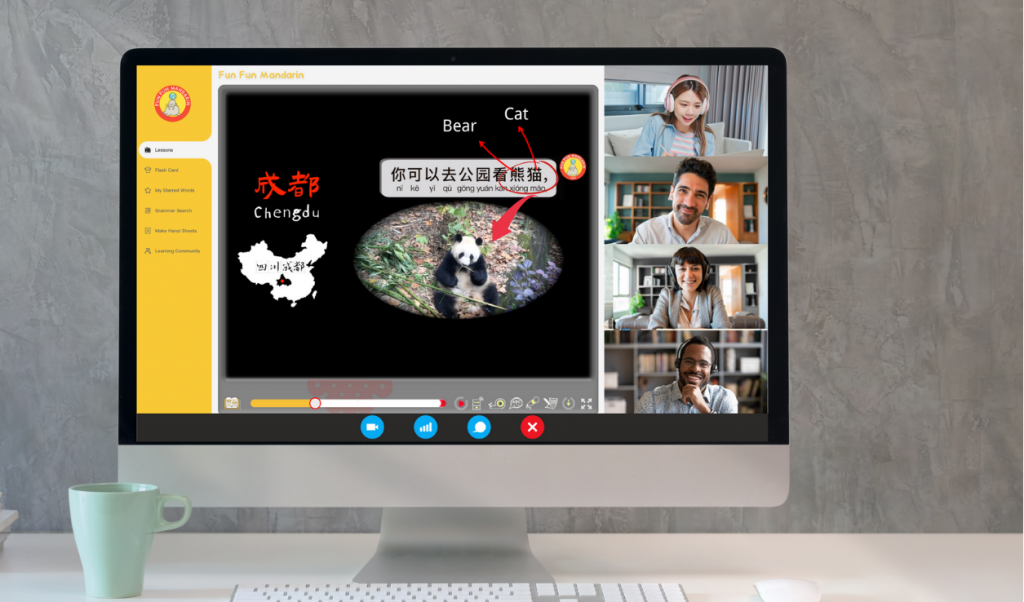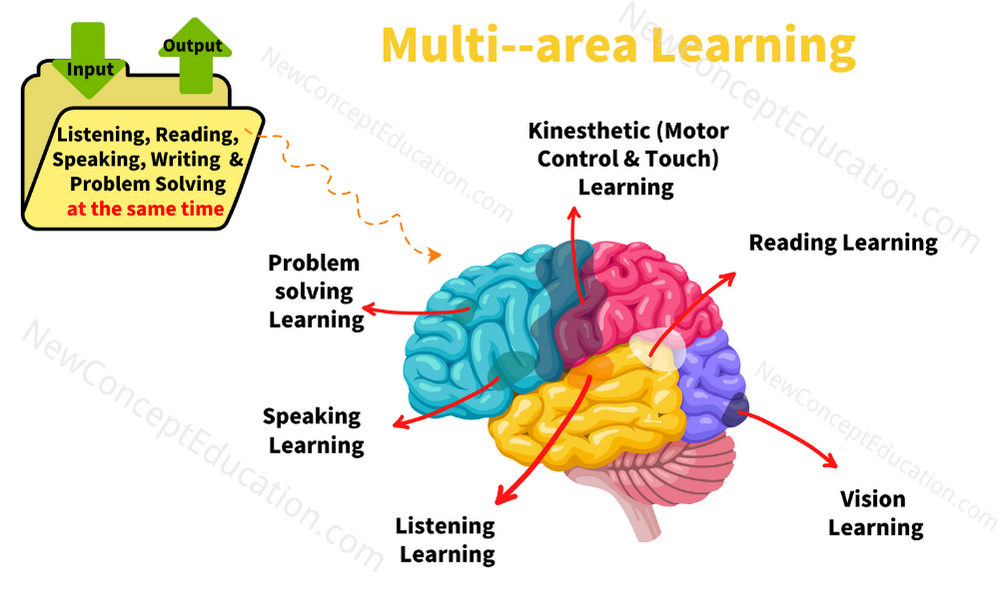4 Tips For How to Learn Chinese Fast?

Powerful Guidance: Learning Chinese Quickly
Knowing how your brain learns a new language will help you to learn Chinese quickly, easily, and effectively! Today, our NewConcept Education research team wants to share the latest on scientific brain research to help you productively learn Chinese. It’s called “FAST”, an acronym of four words: The F is Forget, A is Active, S is State, and T is Teaching.
1. Forget
The human brain processes language information through images. How do children learn languages? Why can they learn a language very quickly? While some structures of their cranial nerves are different from adults, they also process language directly with images and sounds. However, what do adults do when learning languages? When adults learn Chinese, they are often imprisoned by their mother tongue, so they will first translate a word into their mother tongue, and only then remember it. This is one more conversion compared to the child. For example, when an adult is learning the vocabulary word “Apple”, he or she will first think of the English word “apple”, and then translate it into the Chinese word “苹果Píngguǒ”, but children will not have this conversion; you tell them “苹果Píngguǒ” and they will remember the Chinese word “苹果Píngguǒ” directly.
So, when you learn Chinese, you must learn to “Forget”. Forget your native language and native grammar and use the thinking of the target Chinese language to learn. You may hear that one of the most effective ways is the immersion learning method. Mandarin immersion classes are conducted 90% in the target language to let students immerse themselves in such an environment and learn directly. It makes learning Chinese more efficient.
However, above 80% of adults reflect that the immersion learning method is very challenging for them, especially adults who are Chinese language beginners. It is hard to get used to and feel comfortable learning in an immersive Mandarin class.
Build The Bridge To Fill The Challenge Gap For Immersion Learning & To Help You Practice “Forgetting”.
Based on our research, there are some conflicts when learning Chinese with traditional learning materials, such as paper textbooks, e-books, teachers’ handouts, PowerPoints, and even phone apps, because those are text or audio based on one-dimensional learning methods with standardized materials. The one-dimensional learning and practicing of very simple sentences, short sentences, or phrases, make Chinese learners feel it is hard to synthesize their knowledge to apply in communication. The complexity of real-life situations and the difficulty of understanding Chinese grammar makes it hard to remember what they learned. Especially listening and speaking—they feel those are the most challenging to learn in Chinese.
To solve these problems and fill the gap, the NewConcept Education academic team adopted the storytelling teaching method—using one of the most powerful language learning strategies within the immersion learning method to build the storytelling video-based platform Fun Fun Mandarin for Chinese learners (Figure 1). It supports learning Chinese inside and outside class and reflects real-life situations.

For Chinese language input, different versions of storytelling videos create an immersive Chinese environment because students can imitate the pronunciation and choose the most comfortable way to learn Chinese, such as adjusting the speed, turning the Pinyin or English subtitles on or off, etc. When students are watching these videos and following the storyline, they are immersing themselves in the situation. They feel they are doing all those things in China, and the attractive storyline episodes create inner motivation for Chinese learners to keep learning because they want to know the story’s ending.
Also, animation videos provide great examples for using Chinese in real-life contexts which reinforces not only specific vocabulary or specific grammar rules, but also emphasizes core structural differences in different kinds of real-life situations. In addition, because our videos combine with visual learning, they activate the image processing section of the brain for language learning, not just the parts that are activated when memorizing digital flashcards in apps, traditional books, and translating workbooks.
Below are students’ positive opinions about their Chinese learning experience from our qualitative research:
Jason: ‘You get a more kind of richness from storytelling videos. When you have more input, like when you watch a video of a real-life situation or you are practicing a real-life situation, you put yourself in somebody’s shoes. I think that helps your brain remember much better, you can remember that language more efficiently.’
Stephanie: ‘I member a lot of the mandarin videos because of the moving pictures, the cartoon, rather than learning from boring texts. It is easy to trigger long term visual memorization.’
Casey: ‘The videos are immersive in all those ways: you are reading, you are listening, you are recognizing the meaning and you are practicing speaking. So, I think that helps a lot too as opposed to just repeating the same basic vocabulary or sentence of audio over and over on phone Apps or paper textbooks.’
They feel storytelling videos are attractive, fun, and less stressful. They’re super helpful to practice the “Forget”.
For Chinese language output, the different versions of videos (immersive normal speed version, slow speed + English subtitle version, dubbing video version) in the platform improve their listening and speaking skills most, followed by their reading skills. They all agree the dubbing video function plays a key role in language output.
2. Active
An important way to develop learning Chinese initiative is to ask questions and use questions to drive learning. The goal of learning Chinese is for communication. A very important skill is to learn how to ask a question and keep asking follow-up questions to keep a conversation going.
For example, in our NewConcept Education Mandarin classes, starting from the 1.5 months (2 times/week class), students practice using learned vocabulary to naturally ask questions and engage with classmates in collaborative storytelling. When students use their existing vocabulary to ask for information about their classmates, this is a process of actively understanding each other. Also, when students engage in a project, such as creating a digital storybook, they also design five questions based on their story to interact with their audience to check their reading comprehension (Figure 2)

When students read their classmates’ Chinese storybooks, they not only can understand the content, but also can answer the author’s questions. It brings a huge sense of achievement, grows confidence, and increases learning motivation (Figure 3)

3. State
When learning Chinese, consider using multiple senses, including eyes, ears, mouth, and hands at the same time. It will help you remember Chinese better. For example, if you want to remember something, you can speak it aloud while watching and writing it with a pen at the same time. The knowledge obtained from different senses will stimulate different areas of the brain. When we use multiple senses to learn, the memory will also be stored in different brain areas, which is equivalent to learning Chinese many times at the same time, and the memory will be deeper.

NewConcept Education developed the Mandarin Classes based on this effective learning strategy. That is why our students can master Chinese within 6 months easily and quickly.
4. Teaching
You may have encountered a situation where you feel that you have mastered a topic you learned, but once you try to use it or explain it to others, you find that your understanding is actually not clear.
So, if you want to thoroughly master your Chinese language skills, the best way is to be able to teach others. Our small, 4 person chinese classes in Seattle provides these opportunities for you to interact with your peers, letting you become a teacher, and go through the process of internalizing the knowledge that you have learned by teaching others. This is the process of teaching and learning. You teach while doing reflection, while correcting wrong concepts, step by step, and finally, achieve the goal of effectively learning Chinese.
NewConcept Education is building the bridge to help our students overcome any challenge to learning Chinese. We already help many students to achieve success! We are here to help you easily jump into real-world immersive situations to learn Chinese without memorization!



